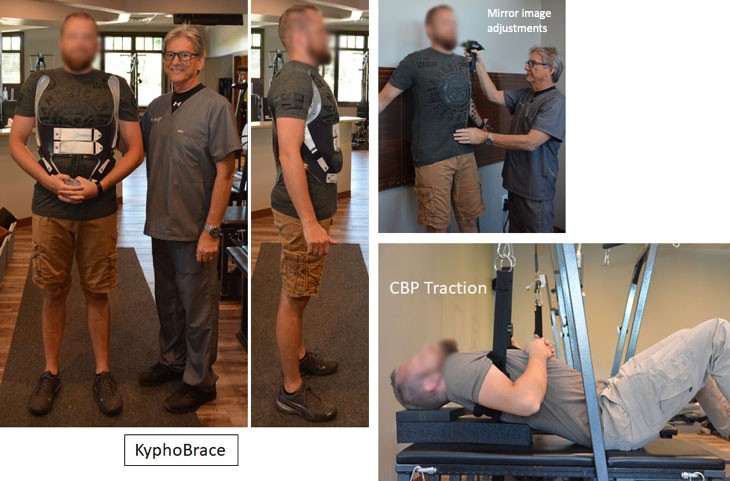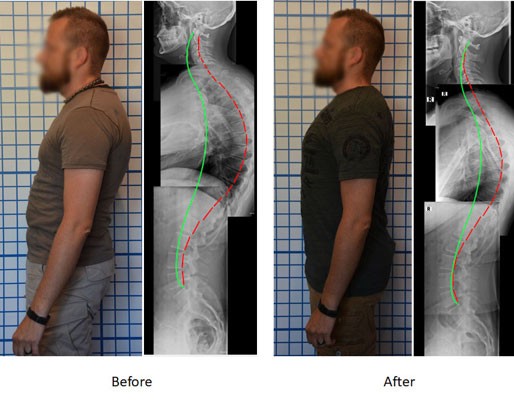The management of an adult male with hyper-kyphosis using a rigid thoracolumbosacral orthosis and manual therapy approach
Authors:
- Ratcliff, J. – Scoliosis Center of Utah. Utah, United States.
- Dean, K. – Scoliosis Center of Utah. Utah, United States.
- McAviney J. – ScoliCare. Sydney, Australia.
- Brown BT. – Macquarie University. Sydney, Australia.
Background:
There is a paucity of research data pertaining to the conservative management of adult spinal deformity, particularly hyper-kyphosis. Given that overt changes in sagittal balance are associated with increased morbidity, and that the incidence of these changes increases with age, it is imperative that strategies aimed at reversing/minimizing this type of deformity are explored.
Aim:
- The aim of this presentation is to detail the successful management of an adult patient with hyper-kyphosis cases using a novel thoracolumbosacral orthosis (KyphoBrace) and multi-modal manual therapy approach
Case Details
32-year-old, male, Caucasian, correctional officer
Five years prior to the initial consultation the patient had been involved in an altercation with inmates that resulted in him losing in consciousness
Presenting Symptoms:
- Neck pain: constant 2-4 /10 Visual Analogue Scale (VAS)
- Lower back pain: constant 2-4/10 VAS
- Headaches: constant 2-4/10 VAS
Other:
- Vertigo, fatigue, migraines, anxiety, insomnia and shoulder pain
Management Plan
Active Care:
– Rigid thoracolumbosacral orthosis (KyphoBrace):
- 8-10 hours
– Mirror image exercises
– Home Denneroll orthotic device use (20 minutes daily)
– Frequency:
- Daily
Passive Care:
– Mirror image Chiropractic adjustments
– Chiropractic Biophysics traction
– Frequency:
- 3 x per week
![Hyper-kyphosis-and-significant-posterior-sagittal-imbalance–(-60mm)-[T1-S1] Hyper-kyphosis and significant posterior sagittal imbalance](https://scoliosiscenterofutah.com/wp-content/uploads/2020/06/Hyper-kyphosis-and-significant-posterior-sagittal-imbalance-60mm-T1-S1.jpg)
Hyper-kyphosis and significant posterior sagittal imbalance
(-60mm) [T1-S1]
KyphoBrace
The KyphoBrace (right) is a customized, lightweight, rigid, thoracolumbosacral orthosis (TSLO) made from polypropylene copolymer
The brace is designed to normalize the sagittal alignment and balance:
- Via a three-point-pressure brace-action the orthosis encourages extension through the thoracic spine thereby reducing hyper-kyphosis and improving sagittal alignment
See More Case Study – Thoracolumbar Scoliosis Treatment

Outcomes: 9 months post-treatment
Thoracic Kyphosis angle:
- Out-of-brace
- Reduced from 74° to 55° (Cobb)
Posterior sagittal imbalance:
- Reduced from -60mm to -20mm (T1-S1)
Neck pain, lower back pain and headaches:
- Significant reduction in frequency and mild reduction in intensity
Other:
- Significant reduction the frequency of vertigo, fatigue, migraines, anxiety, and insomnia

Conclusion
This case study highlights that the KyphoBrace, in combination with a multi-modal manual therapy approach, may be useful in reducing the magnitude of abnormal sagittal plane curves and reducing symptoms in adults with hyper-kyphosis
Further investigation into this type of treatment is warranted
Conflict of Interest
Jeb McAviney:
- Owner and director of ScoliCare, a company that provides treatment and educational products for practitioners, and patients with scoliosis and related spinal disorders
- Creator of the ScoliBrace orthosis and related orthoses and the ScoliRoll rehabilitation tool
Benjamin Brown:
- External research consultant for ScoliCare
No other conflicts to declare
Contact Infomration
Dr. Benjamin Brown
Department of Chiropractic
Faculty of Science and Engineering
Macquarie University, NSW, 2109
Australia
Email: [email protected]
Phone: +61 434 209 812
